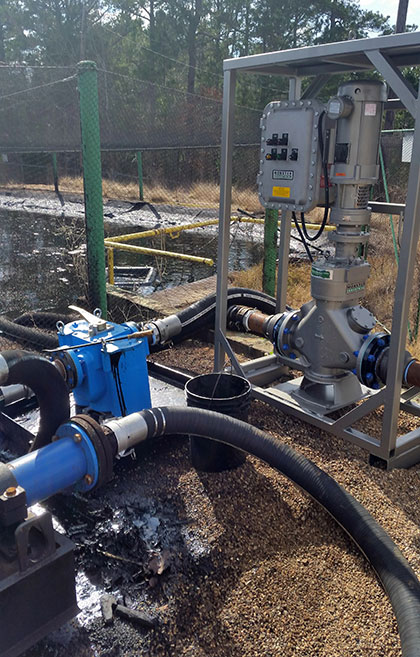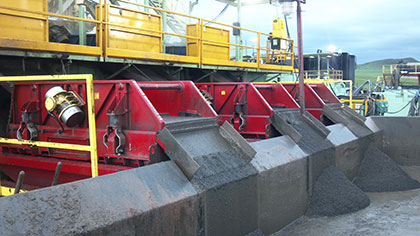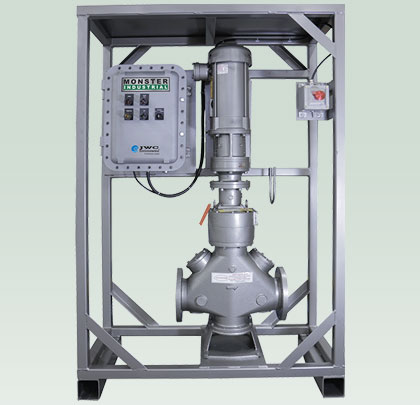One of the most important issues influencing the profitability of industrial and manufacturing operations is maximizing equipment uptime to maintain a consistent throughput of production. This is clearly a priority in all aspects of the oil and gas industry, which relies heavily on the movement of fluids in closed systems, where production can be slowed or brought to a standstill because of a clogged valve or pump.
Crude oil refineries and drilling sites are especially at risk because of the high-solids content of slurries moving through these operations, particularly relating to storage tank bottom cleaning at refineries and the reclamation of drilling fluids at the drill sites. Pumps, centrifuges, and liquid-solid separators, critical to keeping production moving in these operations, are subjected to extremely demanding industrial conditions, being under a constant onslaught of hydrocarbons like paraffins and asphaltenes, and inorganic solids like rock, sand, rust, and heavy metal oxides. Consequently, this equipment experiences a high incidence of interruption and repairs, impacting production throughput and operational costs.
Increasingly, drill sites and refineries are now relying on powerful in-line grinders to protect their costly downstream processing equipment. These grinders are powerful enough to grind down rocks, wood debris and paraffin sludge, to ensure pumps do not clog, and that liquid-solid separators and centrifuges receive properly-sized content for separation, enabling them to operate at optimum throughput without interruption.

CRUDE OIL TANK BOTTOM SLUDGE REMOVAL
One of the most challenging issues for refineries is the development of methods to minimize the cost for removing and disposing of crude oil sludge in storage tank bottoms. Crude oil sludge from storage tanks is a multiphase water/oil/solid composite, composed primarily of heavy hydrocarbon deposits, paraffin, and asphaltene, and possessing a semisolid physical state. It is produced under normal storage conditions by the gradual sedimentation of heavy oil components, varying in consistency, density, thickness, and composition across the whole tank bottom.
Inorganic solids in the crude oil, such as clay, silica, calcite, and corrosion-produced residues contribute to this process, bringing more hardness and higher density to the deposit. The accumulating sediment compacts, resulting in a thick layer of sludge, which is difficult to remove. The sludge can accumulate to many feet in depth and up to 100,000 barrels in volume, which causes a gradual reduction in the tanks’ storage capacity, and uncertainty of available volume. Refineries have inspection policies to verify the integrity of tank seals, flooring, and roofs. To perform these periodic maintenance and inspection programs, the sludge must be removed.
THE CHALLENGES OF CLEANING THE TANK
Tank cleaning, in the traditional sense, has involved opening or cutting a hole in the tank to remove the sludge, which is then openly transported to shaker screens, fed through a liquid/solids separator or centrifuge to reduce the volume of sludge waste, and subsequently transported to an off-site location. This process, however, has come under scrutiny. Frequent throughput interruptions, in part caused by malfunctions with shaker screening systems, add time into an already lengthy method. Because it is a process open to the environment, sludge spills do occur, as well as allowing volatile hydrocarbons to evaporate, raising issues with plant emissions, which, in some states has caused the process to be restricted.
In response to these concerns, the petroleum industry has developed better, safer, quicker, and less expensive methods for doing tank cleaning, and where tank bottom hydrocarbons can be recovered and recycled back to the refining process. These systems are overwhelmingly closed-loop processes, where, once removed, the hydrocarbons are recovered via enclosed external systems, such as centrifuges and liquid-solid separators.
CLOSED-LOOP SYSTEMS
Many of these closed-loop systems are designed to improve throughput efficiency by reducing the size of solids in the slurry-sludge solution, to protect downstream pumps, valves, centrifuges, and liquid/solids separators.
“In a closed-loop system for cleaning crude oil tanks, everything in that tank exits through a pump, before going to a centrifuge or liquid/solids separator, and then gets pumped back again into the tank under high pressure,” says Charlie Gioielli, industrial markets manager with Hahn of Houston, Texas, a leading distributor and service center for pumps used in the oil and gas industry.
“Crude oil sludge is hard, it crumbles, it settles fast, and it is abrasive,” adds Gioielli. “The pumps are producing in the vicinity of 1,500 psi, a lot of pressure that is being pushed through a relatively small passageway. Anything of size that gets in that passageway can block it, and cause the pump to fail. That stops the throughput dead, right there, until it gets de-clogged, or if necessary, the pump repaired or replaced.”

THE ROLE GRINDERS CAN PLAY
“The solution to prevent the pump from clogging is to install an in-line grinder before the pump,” continues Gioielli. “We recommend powerful dual-shafted, slow-speed, high-torque grinders that can handle up to 6,860 gallons per minute and easily shred the toughest hydrocarbons, rust, rocks, and whatever debris might come through from the tank.”
The grinders serve a dual-purpose. Not only do they protect the pumps from clogging and damage, but they provide a consistent particle size for optimum centrifuge performance. Randomly too big and too small particles inhibit their performance.
Centrifuges are used frequently in these closed-loop systems,” explains Gioielli. “The more consistent the particle size, the faster they can be fed the sludge for separation, which reduces the overall time required for tank cleaning and hydrocarbon recovery.”
A LOOK AHEAD
The uses of grinders in petroleum-related pump situations can vary widely, from complex crude oil tank-bottom cleaning to simple portable grinders used on location. In next month’s conclusion, we’ll take a closer look at reclamation of drilling mud from drill cuttings as well as the use of grinders for protecting pumps in petroleum applications.
For More Information
JWC Environmental designs, builds, and services the world’s most dependable waste shredders and screening systems to help municipal facilities and industrial companies solve challenging waste reduction and recycling applications. Founded in 1973, the company has built and shipped over 35,000 Monster shredders and screens to its customers around the world, in diverse industries like energy, wastewater, recycling, oil, chemicals, marine, and facility management. For more information, contact Kevin Bates, director of global marketing, JWC Environmental; at 949.833.3888 or kevinb@jwce.com; or visit www.jwce.com.
____________________________________________
MODERN PUMPING TODAY, January 2018
Did you enjoy this article?
Subscribe to the FREE Digital Edition of Modern Pumping Today Magazine!



